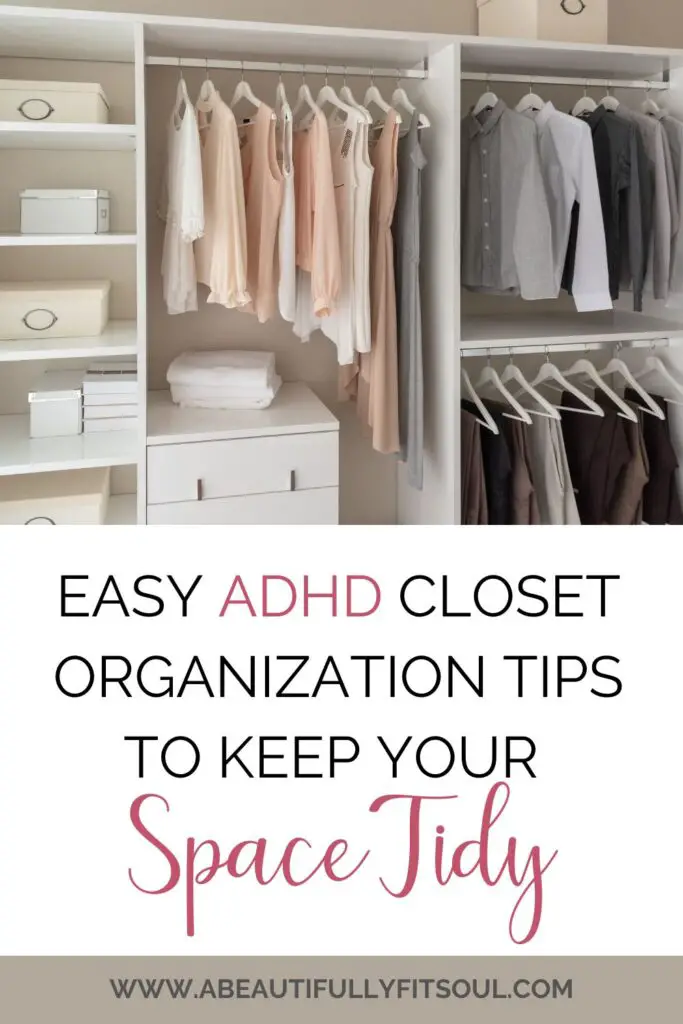If you have ADHD, you’re probably no stranger to the struggle of keeping your space organized and clutter-free. The constant distraction and difficulty with focus can make it nearly impossible to maintain a tidy closet. But fear not – there are easy and practical ADHD-friendly organization tips to help you conquer the chaos and finally have a neat and orderly closet. Say goodbye to the mess and hello to a more organized and stress-free space with these simple tips.
*This post may contain affiliate links, which means I will earn a small commission if you purchase through my link. Please see full disclosure for more information.
The struggles of a messy closet
Living with a messy closet can be a never-ending battle for individuals with ADHD. The constant struggle to find items, the accumulation of clutter, and the overwhelming feeling of disorganization can add unnecessary stress to daily life. Understanding the struggles of a messy closet is the first step to finding effective solutions and creating a more harmonious living environment.
One of the main challenges of a messy closet is finding specific items when needed. Whether it’s a favorite sweater, a pair of shoes, or important documents, the disarray can make it nearly impossible to promptly locate what you’re looking for. This can result in frustration, wasted time, and added stress to your already busy schedule.
Decluttering and categorizing: The key to a tidy space
Another struggle is the accumulation of clutter. Without a system for organizing belongings, items tend to pile up, creating a chaotic environment. From clothes that no longer fit to random odds and ends, the clutter can quickly become overwhelming and make it difficult to navigate through your closet. As a result, you may be unable to utilize the space effectively, leading to wasted storage potential.
The disorganization of a messy closet can also hurt mental well-being. Studies have shown that physical clutter can contribute to anxiety and overwhelm. Finding peace and calm can be challenging when your living space is in disarray. This can further exacerbate the symptoms of ADHD, making it even harder to focus and stay organized.
Lastly, a messy closet can impact your overall productivity and efficiency. When your belongings are scattered and unorganized, it’s easy to lose track of important items or forget tasks that need to be completed. This can result in missed deadlines, forgotten appointments, and a general sense of unpreparedness. By addressing the struggles of a messy closet, you can create a space that supports your productivity and helps you stay on top of your responsibilities.
The next section will explore practical organization tips for individuals with ADHD. With these strategies, you can transform your messy closet into a functional, stress-free space that enhances your daily life. Say goodbye to the struggles of a messy closet and hello to a more organized and peaceful living environment.

Get decluttering, my friends!
Now that you understand the struggles of a messy closet for individuals with ADHD, it’s time to tackle the clutter head-on with some practical organization tips. Decluttering your closet will help you find items more easily and create a more organized, stress-free living environment. Here are some easy ADHD closet organization tips to get you started:
1. Set aside dedicated time: Schedule a specific time to declutter your closet and stick to it. Breaking the task into smaller, manageable chunks can make the process less overwhelming. Consider setting a timer for each decluttering session to stay focused and avoid getting sidetracked.
2. Categorize your belongings: Before starting the decluttering process, sort your belongings into categories. This can include clothing, shoes, accessories, documents, and any other items you store in your closet. Categorizing will help you see the extent of your belongings and decide what to keep and let go of.
3. One in, one out rule: To prevent your closet from becoming cluttered again, implement the “one in, one out” rule. Remove one item of a similar category for every new item you bring into your closet. This will help you maintain a balanced and clutter-free space.
Get creative with storage solutions
4. Use storage solutions: Invest in solutions that maximize space and organize belongings. This can include bins, baskets, dividers, and shelving units. Utilize vertical space by installing hooks or hanging organizers for bags, belts, or scarves. Clear storage containers will allow you to see what’s inside easily.
5. Keep frequently used items accessible: Place items you use regularly within easy reach. This can include your favorite clothing items, shoes, or accessories. Organize them in a way that makes sense to you, whether by color, season, or preference. This will save you time and frustration when getting ready each day.
6. Let go of what no longer serves you: One of the most challenging aspects of decluttering is letting go of items with sentimental value or those you think you might need someday. Remember, keeping items that no longer serve a purpose only adds to the clutter and makes it harder to find what you truly need. Be honest and ask if each item brings you joy or enhances your life. If not, consider donating, selling, or recycling it.
7. Maintain a regular cleaning routine: Once you’ve decluttered and organized your closet, it’s important to maintain it. Set aside a few weekly minutes to tidy up and return things to their designated places. This will prevent clutter from accumulating again and help you stay organized in the long run.
Remember, organizing your closet is an ongoing process. As your needs and preferences change, you may need to reassess and adjust your organization system. By implementing these ADHD closet organization tips and staying committed to a clutter-free lifestyle, you can create a space that supports your well-being and daily productivity.

Sorting it out: The Marie Kondo method (but with an ADHD twist)
The Marie Kondo method has recently gained popularity for its decluttering and organizing approach. With a few tweaks, individuals with ADHD can adapt this method to suit their needs and create a more organized and functional closet. Here’s how to apply the Marie Kondo method with an ADHD twist:
1. Set a clear goal: Before diving into decluttering, define your goal for your closet. Visualize how you want your space to look and function. This will give you motivation and a clear vision to work towards.
2. Break it down: Decluttering can be overwhelming, especially for individuals with ADHD. Break the task into smaller, manageable steps. Focus on one category at a time, such as clothing, shoes, or accessories. This will prevent decision fatigue and make the process more manageable.
3. Keep what sparks joy: The Marie Kondo method emphasizes keeping items that spark joy in your life. Apply this principle to your closet organization by asking yourself if each item brings you joy and serves a purpose. If not, it may be time to let go. Decluttering is not about getting rid of everything but keeping only what you truly love and need.
Simple steps to maintain your organized space
4. Use visual cues: Visual cues can be helpful for individuals with ADHD to stay organized. Consider using clear storage containers or transparent bins to see the contents easily. Use labels or color-coded tags to identify different categories of items quickly. These visual cues will make finding what you need easier and maintain an organized closet.
5. Create designated spaces: ADHD individuals thrive on structure and routine. Create designated spaces for specific items in your closet. This will help you maintain organization and quickly locate things when needed. For example, designate a section for tops, bottoms, and accessories. Giving each item a specific place will make you less likely to misplace or lose things.
6. Practice the one-touch rule: The one-touch rule is a helpful strategy to prevent clutter from accumulating. When decluttering, try to decide on each item with just one touch. Avoid shuffling items around or putting them aside for later. Making quick decisions will save time and prevent piles of items from building up.
7. Regular maintenance: After completing the decluttering process, it’s important to maintain your organized closet. Schedule regular maintenance sessions to tidy up and put things back in their designated places. Set reminders or create a weekly routine to ensure your closet stays clutter-free.
Wrapping Up
Remember, the ultimate goal of organizing your closet is to create a space that supports your well-being and daily productivity. By incorporating the Marie Kondo method with an ADHD twist, you can find joy in your closet and make it a functional and stress-free space.
In the end, keeping your ADHD closet organized doesn’t have to be a daunting task. These easy tips allow you to transform your space into a tidier and more functional area. Connect with me on Instagram or join my private Facebook group for more organizational inspiration and support! Let’s help each other conquer clutter and create a peaceful living environment!



